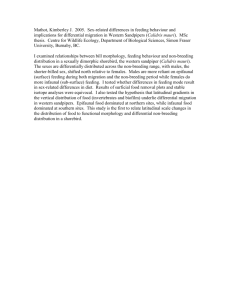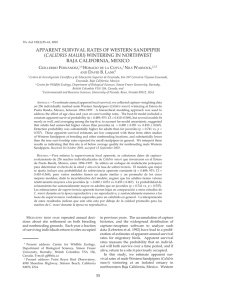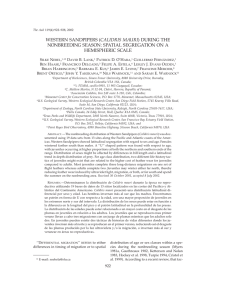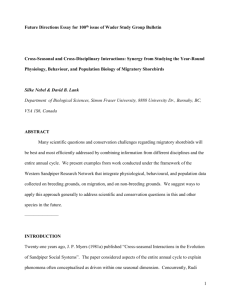TROPICAL AND SUBTROPICAL WESTERN SANDPIPERS CALIDRIS MAURI HISTORY STRATEGIES
advertisement
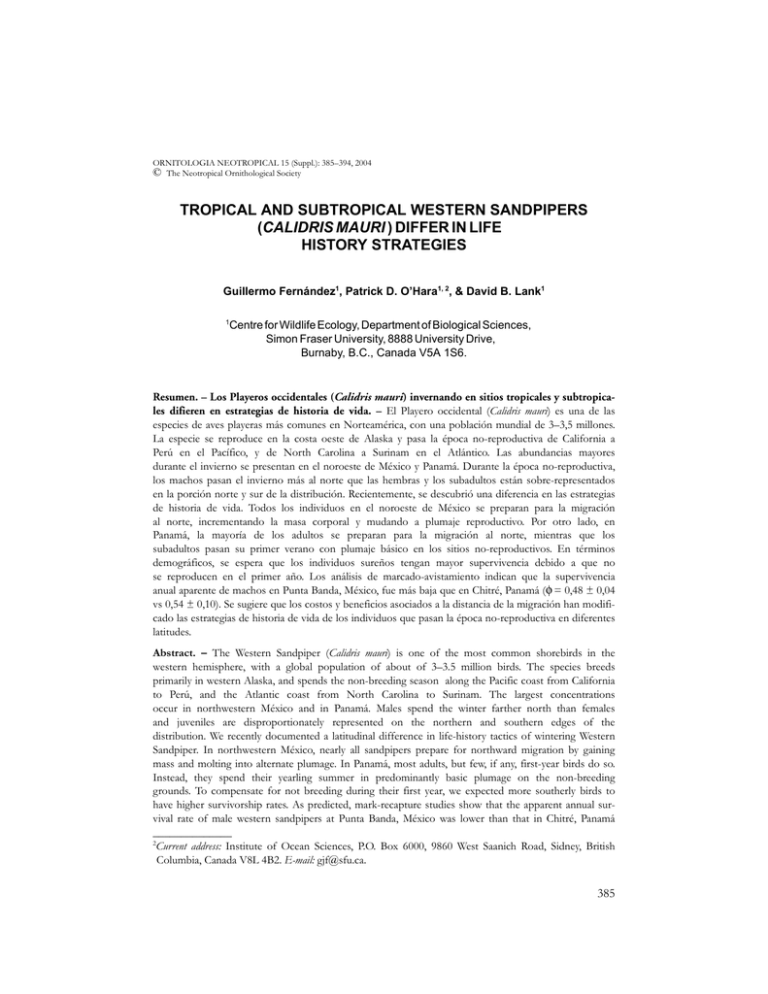
ORNITOLOGIA NEOTROPICAL 15 (Suppl.): 385–394, 2004 © The Neotropical Ornithological Society TROPICAL AND SUBTROPICAL WESTERN SANDPIPERS (CALIDRIS MAURI ) DIFFER IN LIFE HISTORY STRATEGIES Guillermo Fernández1, Patrick D. O’Hara1, 2, & David B. Lank1 1 Centre for Wildlife Ecology, Department of Biological Sciences, Simon Fraser University, 8888 University Drive, Burnaby, B.C., Canada V5A 1S6. Resumen. – Los Playeros occidentales (Calidris mauri) invernando en sitios tropicales y subtropicales difieren en estrategias de historia de vida. – El Playero occidental (Calidris mauri) es una de las especies de aves playeras más comunes en Norteamérica, con una población mundial de 3–3,5 millones. La especie se reproduce en la costa oeste de Alaska y pasa la época no-reproductiva de California a Perú en el Pacífico, y de North Carolina a Surinam en el Atlántico. Las abundancias mayores durante el invierno se presentan en el noroeste de México y Panamá. Durante la época no-reproductiva, los machos pasan el invierno más al norte que las hembras y los subadultos están sobre-representados en la porción norte y sur de la distribución. Recientemente, se descubrió una diferencia en las estrategias de historia de vida. Todos los individuos en el noroeste de México se preparan para la migración al norte, incrementando la masa corporal y mudando a plumaje reproductivo. Por otro lado, en Panamá, la mayoría de los adultos se preparan para la migración al norte, mientras que los subadultos pasan su primer verano con plumaje básico en los sitios no-reproductivos. En términos demográficos, se espera que los individuos sureños tengan mayor supervivencia debido a que no se reproducen en el primer año. Los análisis de marcado-avistamiento indican que la supervivencia anual aparente de machos en Punta Banda, México, fue más baja que en Chitré, Panamá (φ = 0,48 ± 0,04 vs 0,54 ± 0,10). Se sugiere que los costos y beneficios asociados a la distancia de la migración han modificado las estrategias de historia de vida de los individuos que pasan la época no-reproductiva en diferentes latitudes. Abstract. – The Western Sandpiper (Calidris mauri) is one of the most common shorebirds in the western hemisphere, with a global population of about of 3–3.5 million birds. The species breeds primarily in western Alaska, and spends the non-breeding season along the Pacific coast from California to Perú, and the Atlantic coast from North Carolina to Surinam. The largest concentrations occur in northwestern México and in Panamá. Males spend the winter farther north than females and juveniles are disproportionately represented on the northern and southern edges of the distribution. We recently documented a latitudinal difference in life-history tactics of wintering Western Sandpiper. In northwestern México, nearly all sandpipers prepare for northward migration by gaining mass and molting into alternate plumage. In Panamá, most adults, but few, if any, first-year birds do so. Instead, they spend their yearling summer in predominantly basic plumage on the non-breeding grounds. To compensate for not breeding during their first year, we expected more southerly birds to have higher survivorship rates. As predicted, mark-recapture studies show that the apparent annual survival rate of male western sandpipers at Punta Banda, México was lower than that in Chitré, Panamá ______________ 2 Current address: Institute of Ocean Sciences, P.O. Box 6000, 9860 West Saanich Road, Sidney, British Columbia, Canada V8L 4B2. E-mail: gjf@sfu.ca. 385 FERNÁNDEZ ET AL. (φ = 0.48 ± 0.04 vs. 0.54 ± 0.10). We suggest that costs and benefits associated with migratory distance have altered the life-history strategies for sandpipers spending the non-breeding season at different latitudes. Accepted 10 January 2004. Key words: Western Sandpiper, Calidris mauri, non-breeding season, life-history strategies, latitudinal dependent, timing of first breeding. INTRODUCTION Bird migration allows individuals to exploit seasonally variable environments, but there is often widespread variation, even within species, in migration distance (Berthold 1999). This variability may have demographic consequences, such as higher mortality costs with longer migration distance, or productivity or survivorship differences from remaining in or moving to particular breeding or wintering areas (Greenberg 1980, Ketterson & Nolan 1982, Myers et al. 1985). Ecological basis for such effects include variation in environmental conditions, resource availability, competition, predation danger, or even parasite loads (Myers et al. 1985, Castro et al. 1992, Piersma 1997, Hockey et al. 1998, Lank et al. 2003). Moreover, each of these ecological factors may be distributed as environmental gradients with respect to migration distance. Young birds of many shorebirds species defer northward migration in their first summer (McNeil et al. 1994, Summers et al. 1995, Hockey et al. 1998, O’Hara et al. 2002). The likelihood of summer residency by yearlings among species increases with migration distance, body size, and longevity (Summer et al. 1995). Summer residency delays the age of first breeding, which strongly affects lifetime fitness (Ricklefs 2000). In this paper, we present evidence documenting an intraspecific latitudinal difference in the migration versus residence strategy in Western Sandpipers (Calidris mauri, Scolopacidae), and explore the demographic consequences. In short, we demonstrate that life-history tactics changes 386 with where juveniles spend their first nonbreeding season. Two salient features distinguish the distribution of Western Sandpipers in the western hemisphere. First, more Western Sandpipers breed in a relatively restricted range in western Alaska and the Chutotski Peninsula (Wilson 1994). Breeding birds are monogamous and male-territorial (Lanctot et al. 2000). Second, during the non-breeding season, Western Sandpipers occur along the Pacific coast from California to Perú, and the Atlantic coast from North Carolina to Surinam (Wilson 1994). The largest concentrations occur in northwestern México (Morrison et al. 1994, Engilis et al. 1998) and in Panamá (Morrison et al. 1998). In addition, Western Sandpipers have latitudinal segregation in sex and age during the non-breeding season (Nebel et al. 2002). Males spend the winter farther north than females, and juveniles are disproportionately represented on the northern and southern edges of the distribution. The combination of a restricted breeding range and a broad non-breeding range means that some sandpipers migrate much farther than others. Birds wintering in Panamá travel approximately 18,000 km in a round-trip, while birds wintering in México may travel 12,000 km. We present data on population structure during the wintering period (November– December), body mass gain during the premigratory preparatory period (February–April), and prealternate body molt of Western Sandpipers at three sites across the non-breeding range. We also present apparent annual survival rates for two of the sites. These analyses WESTERN SANDPIPER LIFE HISTORY VARIATION extend earlier findings based on more limited data (O’Hara 2002, O’Hara et al. 2002, in prep.). We focus on how migratory distance influences the timing of first breeding for each sex and the life history strategies of Western Sandpipers. METHODS Data collection. Non-breeding Western Sandpipers were captured and observed in México at the Estero de Punta Banda (“Punta Banda”; 31°52’N, 116°37’W), a small coastal wetland located on the northwest coast of the Baja California peninsula, and at Bahía Santa María (“Santa María”; 25°02’N, 108°18’W), a 1350 km2 coastal wetland located on the Sinaloa coast. In Panamá, data were collected at two beaches near Chitré, province of Herrera (08°00’N, 80°50’W). Field work was carried out at Punta Banda and Chitré from November to April 1995–1998, and at Santa María from November to April 1999–2002. At each site, we recorded the individual body mass, exposed culmen length (Prater et al. 1977), and categorized the degree of bright breeding plumage during prealternate body molt. Birds were categorized as juvenile or adult based on plumage (Prater et al. 1977) and/or banding history. We assigned sex based on culmen length (Page & Fearis 1971: males < 24.3 mm, females > 24.7 mm). Western Sandpipers molt into alternate plumage between February and May in preparation for migration (Wilson 1994). The alternate body plumage includes variable numbers of rufous-centred or rufous-edged contour feathers (crown, cheeks, mantle, upper scapulars, and tertials) and coverts (Prater et al. 1977). In México, we scored the contour plumage during prealternate molt using an ordinal scale based on coloration [black, rufous, and chevrons, from 1 = bird in basic plumage to 6 = alternate plumage almost complete, crown feathers fringed with rufous, and chevrons visible on the breast (O’Hara et al. in prep.)]. We scored body molt at Punta Banda from resighted individually color-banded birds and at Santa María, from captured individuals. In Panamá, we scored the extent of bright alternate plumage of captured birds based on the number of body regions [mantle, upper scapulars, tertials, or crown) with rufous, from 1 = no rufous anywhere to 6 = full alternate plumage with rufous in all body regions (O’Hara et al. 2002, in prep.)]. Although we scored plumage using slightly different systems in México and Panamá, the critical focus of this study is intra-site patterns of differences between age classes. Data analyses. For all sites and years, we divided the season into a winter period (November–January) and a premigratory preparatory period (February–April). We defined the premigratory period for adults as starting 1 February, at which time body mass usually started to increase and the prealternate molt became visible (O’Hara et al. in prep). Within sites, we did not find a significant sex effect, so we pooled sex categories. In addition, we did not capture birds of all age-sex categories for all months and years, especially in Punta Banda. Therefore, data were pooled among years within sites. Body masses were compared among age classes using an ANOVA (Proc MIXED: SAS 2002). Wintering and premigratory periods were analyzed separately. Within sites, plumage scores were treated as ordinal response variables and analyzed using logistic regression (Proc LOGISTIC: SAS 2002). We estimated apparent annual survival rates (φ) for Punta Banda (Fernández et al. 2003) and Chitré (O’Hara 2002) using Program MARK (White & Burnham 1999), following the information-theoretic approach (Burnham & Anderson 1998). Apparent survival rate is the probability that a bird survived 387 FERNÁNDEZ ET AL. TABLE 1. Population structure for Western Sandpiper during the wintering season (November-January) at three non-breeding sites. Wintering site Study period Birds captured Proportion male (mean ± SE) Proportion adult (mean ± SE) Apparent annual survival (φ) Sex Male Female Male Female México Punta Banda (31°N) 1995-1998 120 0.84 ± 0.02 0.46 ± 0.06 0.59 ± 0.20 0.48 ± 0.041 0.48 ± 0.042 Santa María (25°N) 1999-2002 1208 0.67 ± 0.05 0.80 ± 0.06 0.67 ± 0.11 – – Panamá Chitré (08°N) 1995-1998 3373 0.41 ± 0.03 0.68 ± 0.0 0.59 ± 0.08 0.54 ± 0.103 0.62 ± 0.133 1 Fernández et al. (2003). Fernández (unpubl.). 3 O’Hara (2002). 2 through that interval and did not permanently emigrate from the study area, controlling for probability of detection. RESULTS Population structure. Sex composition was consistently male-biased at both sites in México, and female-biased in Panamá (Table 1). Age composition varied among sites, but did not differ between sexes within sites (Table 1). Seasonal changes in mass. During the winter, we found small or no significant age differences in body mass within sites (Fig. 1). At Punta Banda, adults (22.72 ± 0.29) and juveniles (22.56 ± 0.28) had similar winter body masses (F1-117 = 0.24, P = 0.62). At Santa María, adults were significantly heavier than juveniles (23.42 ± 0.29 vs 22.89 ± 0.29) (F1-1,205 = 22.03, P < 0.0001), but the difference between age groups was only 0.52 g, SE = 0.11. At Chitré, adults were significantly heavier than juveniles (22.48 ± 0.03 vs 22.31 ± 0.04; F1-3,670 = 8.74, P = 0.003), with a difference of 0.16 g, SE = 0.05. During the premigratory preparatory period (after 1 February), we found different 388 age effects on mass gain within sites (Fig. 1). At Punta Banda, both age classes gained mass in a similar way (F1-149 = 0.27, P = 0.61) as the preparatory period progressed (F1-149 = 34.77, P < 0.0001). At Santa María, both age classes gained mass as the preparatory period progressed (F1-1,208 = 542.26, P < 0.0001), but adults were significantly heavier than juveniles (F1-1,208 = 6.76, P = 0.009). At Chitré, adults but not juveniles gained mass during the preparatory period (age × month: F1-4,086 = 341.04, P < 0.0001). Prealternate body molt pattern. The extent of body molt into bright breeding plumage also differed between age classes among sites (Fig. 2). At Punta Banda, both age classes molted into alternate plumage similarly (Wald χ2 = 0.20, df = 1, P = 0.66) as the premigratory preparatory period progressed (Wald χ2 = 63.40, df = 1, P < 0.0001). In Santa María, both age classes molted into alternate plumage, but adults molted faster than juveniles (age × month: Wald χ2 = 98.36, df = 1, P < 0.0001). The variance among juveniles in April was high, partly due to an apparent sex difference. A higher percentage of females (68%, n = 22) had a molt score higher than WESTERN SANDPIPER LIFE HISTORY VARIATION FIG. 1. Mass seasonal changes in adult and juvenile (both sexes) Western Sandpipers during the wintering (November–January) and premigratory period (February–April) at three non-breeding sites: Punta Banda and Santa María in México, and Chitré in Panamá. Filled circles represent adults, unfilled circles represent juveniles. Shown are means ± 95% CI. Samples sizes are given above the x axis (adults/juveniles). two than did males (36%, n = 47, Fisher’s exact P = 0.01). At Chitré, only adults molted into alternate plumage (Wald χ2 = 732.30, df = 1, P < 0.0001) as the preparatory period progressed (Wald χ2 = 72.55, df = 1, P < 0.0001). Apparent annual survival rates. Previous survival analysis of sandpipers at Punta Banda was performed for males only, due to a limited sample size of females (Fernández et al. 2003). In separate analyses that included both sexes, sex did not affect the model selection process 389 FERNÁNDEZ ET AL. FIG. 2. Prealternate molt patterns in adult and juvenile (both sexes) Western Sandpipers during the premigratory period (February–April) at three non-breeding sites: Punta Banda and Santa María in México, and Chitré in Panamá. Filled boxes represent adults, unfilled boxes represent juveniles. Box plots represent the 5 and 95% percentiles with error bars. The mean is the short dash line and the median is solid line. Samples sizes are given above the x axis (adults/juveniles). and apparent survival rate collapsed to constant apparent survival rate (φ = 0.48) (Fernández unpubl). At Chitré (O’Hara 2002), the best fit model contained sex structure with males having a lower apparent survivorship than females (Table 1). However, both survival rates are higher than that at Punta 390 Banda. Age-structured models had little or no support at either site. DISCUSSION We have presented strong evidence for intraspecific differences in life history strate- WESTERN SANDPIPER LIFE HISTORY VARIATION gies of Western Sandpipers wintering at different latitudes. In México, both age classes have broadly similar patterns of mass gain and molt into alternate plumage during the premigratory period. In contrast, in Panamá, only adults gain mass and molt into alternate plumage. The lack of mass gain and alternate plumage in southerly juveniles indicates that they either substantially delay or completely defer their first northward migration and breeding attempt. In northern México, juvenile preparation for northward migration was statistically indistinguishable with that of adults. Further south, at Santa María, adults gain mass and molt faster, on average, than juveniles, which may reflect a small proportion of juveniles, particularly males, failing to prepare for migration. We conclude that juveniles that migrate farther south remain in non-breeding areas through their first summer. What mechanisms affect the latitudinal threshold of Western Sandpipers migratory decisions? Lower foraging proficiency of young shorebirds has been suggested as being responsible of the evolution of deferred migration (Hockey et al. 1998). In addition, poorer performance by yearling birds may relate to insufficient development of parasite resistance (McNeil et al. 1994). O’Hara (2002) and O’Hara et al. (2002) related the latitudinal trend in oversummering by Western Sandpipers to their lack of a partial or complete wing moult during the first year. Juveniles that migrate north as yearlings accumulate wear from three migrations on feathers grown rapidly on the breeding grounds in their natal year. The feather wear of birds migrating and wintering farther south maybe greater, decreasing survivorship and selecting for deferred migration from more southern sites. The observed latitudinal trend in oversummering was unexpected prior to O’Hara (2002), in part because the Western Sandpiper is a small-bodied species of shorebird (range 18–42 g) (Hockey et al. 1998). Elsewhere, oversummering of comparable size species [e.g., southern Africa: Little Stint, Calidris minuta (range 17–44 g), and Little Ringed Plover, Charadrius dubius (range 26–53 g)], is infrequent (Summers et al. 1995). Other species of small shorebirds have adapted to longer migration distances by evolving partial or complete wing molts during their first nonbreeding season (e.g., Little Stint; Prater et al. 1977), but Western Sandpipers have not done so (O’Hara 2002). The positive relationship between body-size and longevity means that deferring the first northward migration has stronger negative consequences on reproductive success for a small species than for a larger species (Summers et al. 1995). Thus, stronger compensatory increases in survivorship are required for shorter-lived than longer lived species to offset these reproductive costs. Apparent annual winter survival was higher in Panamá than in México, consistent with the hypothesis that Western Sandpipers improve true survivorship by foregoing migration in their first spring. The magnitude of relative lifetime fitness across latitudes is unknown, but we can consider two possibilities. Under an “ideal free distribution” (Fretwell & Lucas 1970), individuals would have similar fitness across sites, at least within sex and age groups, but this could be achieved through compensating sums of survival and reproductive components. Birds wintering farther north and breeding at a younger age would be expected to have higher annual reproductive success, but lower survivorship. Conversely, birds wintering farther south should live longer, but their annual reproductive success, factoring in their lack of reproduction in their first year, should be lower. Apparent survival rates put a lower limit on true survival rates, since they do not distinguish between permanent emigration and mortality (Sandercock 2000). Lower values of φ could represent higher rates of permanent 391 FERNÁNDEZ ET AL. emigration by juveniles from northern México than Panama, as would be implied by the under representation of juveniles in the center of the range. However, at Punta Banda, φ did not differ between age groups, as would be expected if differential juvenile migration contributed heavily to the value from that site (Fernández et al. 2003). We therefore suggest that our apparent annual survival rates are consistent with the ideal free hypothesis, in that winter to winter survivorship appears higher in a more southerly wintering population than at a more northerly site. Further population modeling will be needed to assess whether this difference in fact offsets the loss of potential fecundity in their first year. A similar latitudinal trend in survival was found in the Dark-eyed Junco (Junco hyemalis), with birds wintering farther south having higher survivorship than those wintering farther north (Ketterson & Nolan 1982). However, in that case, the patterns were interpreted as evidence for a despotic distribution, with differential fitness for birds wintering at different latitudes. This interpretation makes sense if deferred migration and breeding is not an offsetting alternative life history option in the juncos. It is possible that expected fitness also vary among wintering sites for Western Sandpipers, but some individuals may be constrained to adopt poorer sites due to social interactions (despotic distributions) or other condition-dependent factors. In this case, individuals settling in poorer habitat should have lower lifetime fitness. How does the life history difference we have documented interact with the differential latitudinal distribution of juvenile males and females (Nebel et al. 2002)? Since males winter farther north, a substantially higher proportion of them should migrate north in their first year than is the case for females. This could skew breeding sex ratios towards excess males, increasing inter-male competition for territories and mates in this socially monoga392 mous species. We would expect to find some males failing to obtain territories and mates, as has been reported for Western Sandpipers (Lanctot et al. 2000). However, this might not occur if females incur sufficiently higher annual mortality to offset excess migrant young males. Female apparent annual survivorship to the breeding grounds is lower than that of males, but some of this is clearly attributed to a higher rate of breeding dispersal (Sandercock et al. 2000). On the other hand, estimates of φ from the wintering grounds produced substantially higher annual apparent female survivorship (O’Hara 2002). A second mechanism that might offset the general pattern is the possibility that the latitudinal threshold at which juvenile Western Sandpipers migrate is further north for females than males, as suggested by the apparent sex difference in the pattern of molt at Santa María. While the consequences of sexual segregation and latitudinal for juvenile migration strategy and age of first breeding at first seem clear, additional data and modeling will be needed to assess the overall effects on life history strategies. ACKNOWLEDGMENTS We thank H. Luquer and P. González for the opportunity to participate at the Shorebird Symposium, and the Dean of Graduate Studies (SFU) for an NSERC-CTA to G. F. to present this paper at the VII NOC. This paper is a collaborative effort that would not be possible without H. de la Cueva, F. Delgado, and N. Warnock. Numerous individuals assisted with fieldwork in Punta Banda, Santa María, and Chitré, including V. Antonio, F. Becerril, A. Buenrostro, A. Castillo, L. Enriquez, M. Guevara, E. Loaiza, U. Noriega, E. Sánchez, and Y. Sandoval. Funding was provided through the CWE at SFU., CWSLatin America Program, CICESE, NSERC grants to F. Cooke and D. B. L., Graduate Fel- WESTERN SANDPIPER LIFE HISTORY VARIATION lowships (SFU) to P. D. O’H., and scholarships from CONACYT (No. 90768) and Government of Canada Award to G. F. Additional financial support was provided by Pronatura NMC, AWRF, and LP-Neotropic Fund. The Smithsonian Tropical Research Institute and J. Christy provided crucial logistical support in Panamá, and Patolandia Hunting Club in Santa María. We thank the communities of Chinitos, Sinaloa, and Playa El Agallito, Panamá for their help during fieldwork. We thank E. Cam, B. K. Sandercock, and C. Schwarz for their advice and discussion about φ, and R. W. Elner, R. Butler, R. C. Ydenberg, F. Cooke, and F. Moore for their input and support. B. Sandercock made valuable suggestions on an earlier version of the manuscript. REFERENCES Berthold, P. 1999. A comprehensive theory for the evolution control and adaptability of avian migration. Ostrich 70: 1–11. Burnham, K. P., & D. R. Anderson. 1998. Model selection and inference: a practical informationtheoretic approach. Springer, New York, New York. Castro, G., J. P. Myers, & R. E. Ricklefs. 1992. Ecology and energetics of Sanderlings migrating to four latitudes. Ecology 73: 833–844. Engilis, A. Jr., L. W. Oring, E. Carrera, J. W. Nelson, & A. Martinez Lopez. 1998. Shorebirds surveys in Ensenada Pabellones and Bahia Santa Maria, Sinaloa, Mexico: critical winter habitats for Pacific Flyway shorebirds. Wilson Bull. 110: 332–341. Fernández, G. H. de la Cueva, N. Warnock, & D. B. Lank. 2003. Apparent survival rates of Western Sandpiper (Calidris mauri) wintering in northwest Baja California, Mexico. Auk 120: 55–61. Fretwell S. D., & H. J. Jr. Lucas. 1970. On territorial behaviour and other factors influencing habitat distribution in birds. Acta Biotheoretica 19: 16– 36. Greenberg, R. S. 1980. Demographic aspects of long-distance migration. Pp. 493–504 in Keast, A., & E. S. Morton (eds.). Migrant birds in the Neotropics. Smithsonian Institution Press, Washington, D. C. Hockey, P. A. R., J. K. Turpie, & C. R. Velásquez. 1998. What selective pressures have driven the evolution of deferred northward migration by juvenile waders? J. Avian Biol. 29: 325–330. Ketterson. E. D., & V. Nolan Jr. 1982. The role of migration and winter mortality in the life history of a temperate-zone migrant, the Darkeyed Junco, as determined from demographic analyses of winter populations. Auk 99: 243– 259. Lanctot, R. B., B. K. Sandercock, & B. Kempenaers. 2000. Do male breeding displays function to attract mates or defend territories? The explanatory role of mate and site fidelity. Waterbirds 23: 155–164. Lank, D. B., R. W. Butler, J. Ireland, & R. C. Ydenberg. 2003. Effects of predation danger on migration strategies of sandpipers. Oikos 103: 303–319. McNeil, R., M. T. Diaz, & A. Villeneuve. 1994. The mystery of shorebird over-summering: a new hypothesis. Ardea 82: 143–152. Morrison, R. I. G., R. K. Ross, & J. P. Guzmán. 1994. Aerial surveys of Nearctic shorebirds wintering in Mexico: preliminary results of surveys on the southern half of the Pacific coast, Chiapas to Sinaloa. Canadian Wildlife Service Progress Notes, no. 209. Ottawa, Ontario. Morrison, R. I. G., R. W. Butler, F. S. Delgado, & R. K. Ross. 1998. Atlas of Nearctic shorebirds and other waterbirds on the coast of Panama. Canadian Wildlife Service Special Publication, Ottawa, Ontario. Myers, J. P., J. L. Maron, & M. Sallaberry. 1985. Going to extremes: why do Sanderlings migrate to the Neotropics? Pp. 520–535 in Buckley, P. A., M. S. Foster, E. S. Morton, R. S. Ridgely, & F. G. Buckley (eds.). Neotropical Ornithology. American Ornithologists’ Union, Washington, D.C. Nebel, S., D. B. Lank, P. D. O’Hara, G. Fernández, B. Haase, F. Delgado, F. A. Estela, L. J. Evans Ogden, B. Harrington, B. E. Kus, J. Lyons, B. Ortego, J. Y. Takekawa, N. Warnock, & S. E. Warnock. 2002. Western Sandpiper (Calidris mauri) during the non-breeding season: spatial 393 FERNÁNDEZ ET AL. segregation on a hemispheric scale. Auk 119: 922–928. O’Hara, P. D. 2002. The role of feather wear in alternative life history strategies of a long-distance migratory shorebird, the Western Sandpiper (Calidris mauri). Ph. D. diss., Simon Fraser Univ., Burnaby, British Colombia. O’Hara, P. D., D. B. Lank, & F. S. Delgado. 2002. Is the timing of moult altered by migration? Evidence from a comparison of age and residency classes of Western Sandpipers Calidris mauri in Panamá. Ardea 90: 61–70. Page, G. W., & B. Fearis. 1971. Sexing Western Sandpipers by bill length. Bird Banding 42: 297–298. Piersma, T. 1997. Do global patterns of habitat use and migration strategies co-evolve with relative investments in immunocompetence due to spatial variation in parasite pressure? Oikos 80: 623–631. Prater, A. J., J. H. Marchant, & J. Vuorinen. 1977. Guide to identification and ageing of Holarctic waders. British Trust for Ornithology, Tring, 394 UK. Ricklefs, R. E. 2000. Density dependence, evolutionary optimization, and the diversification of avian life histories. Condor 102: 9–22. SAS Institute. 2002. SAS® 8.2. SAS Institute Inc., Cary, North Carolina. Sandercock, B. T., D. B. Lank, R. B. Lanctot, B. Kempenaers, & F. Cooke. 2000. Ecological correlates of mate fidelity in two Arctic-breeding sandpipers. Can. J. Zool. 78: 1948–1958. Summers, R. W., L. G. Underhill, & R. P. PrysJones. 1995. Why do young waders in southern Africa delay their first return migration to the breeding grounds? Ardea 83: 351–357. White, G. C., & K. P. Burnham. 1999. Program MARK: survival estimation from populations of marked individuals, version 2. Bird Study 46 (Suppl.): 120–139. Wilson, H. E. 1994. Western Sandpiper (Calidris mauri). In Poole A., & F. Gill (eds.). The birds of North America, No. 90. The Birds of North America, Inc., Philadelphia, Pennsylvania.
